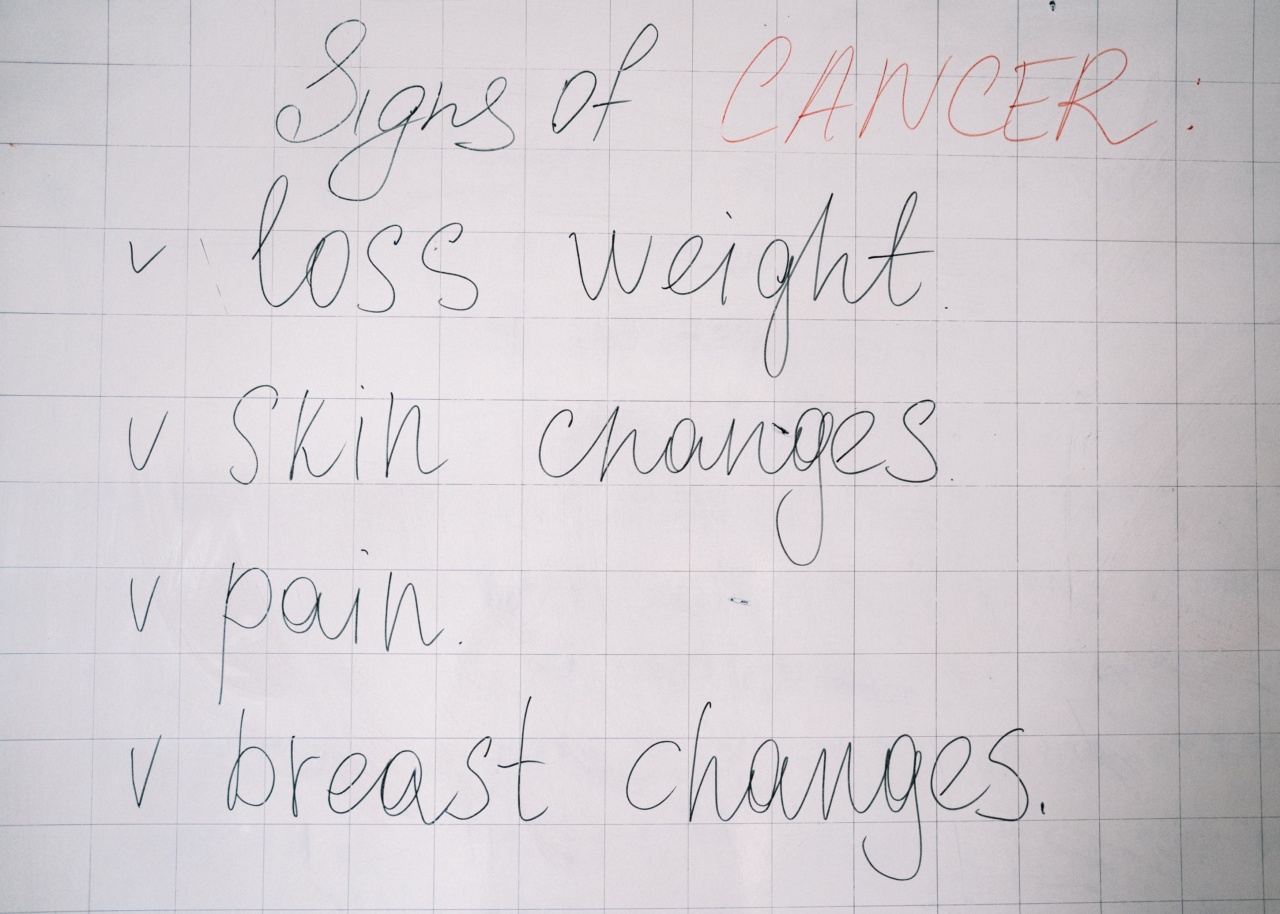When it comes to cancer, early detection is key to successful treatment. Recognizing the symptoms of cancer can be challenging, as they can vary depending on the type and stage of the disease.
However, by familiarizing yourself with some common cancer symptoms through pictures, you may be able to identify potential signs and seek medical advice promptly. In this article, we will explore various types of cancer and their corresponding symptoms, illustrated with pictures for better understanding.
1. Breast Cancer
 .
.
Breast cancer is the most common cancer among women worldwide. Some common symptoms include:.
- Lump or thickening in the breast or armpit.
- Change in breast size or shape.
- Redness, swelling, or warmth in the breast.
- Changes in nipple shape, such as inversion or dimpling.
- Nipple discharge other than breast milk.
2. Lung Cancer
 .
.
Lung cancer primarily affects smokers and individuals exposed to second-hand smoke. Recognize lung cancer symptoms in pictures:.
- Persistent cough that does not go away.
- Blood-streaked sputum or coughing up blood.
- Chest pain that worsens with deep breathing, laughing, or coughing.
- Shortness of breath or wheezing.
- Unexplained weight loss or loss of appetite.
3. Colorectal Cancer
 .
.
Colorectal cancer typically originates in the colon or rectum. Here are some symptoms that may indicate colorectal cancer:.
- Changes in bowel habits, such as diarrhea, constipation, or narrowing of the stool.
- Blood in the stool or rectal bleeding.
- Abdominal pain, cramps, or discomfort.
- Weakness or fatigue.
- Unexplained weight loss.
4. Skin Cancer
 .
.
Skin cancer is often caused by sun exposure and can be identified through various visual cues:.
- Changes in the size, shape, or color of a mole or growth on the skin.
- Irregular borders or edges on a mole.
- Uneven coloring, with different shades of brown, black, or even pink or red.
- Growth that is larger than a pencil eraser or evolves over time.
- Ulceration or bleeding of a mole or growth.
5. Prostate Cancer
 .
.
Prostate cancer affects the prostate gland in men. Recognizing symptoms can prompt early detection:.
- Difficulty urinating or frequent urination, especially during the night.
- Weak urine flow or interrupted urine flow.
- Blood in urine or semen.
- Persistent pain in the back, hips, or pelvis.
- Erectile dysfunction.
6. Ovarian Cancer
 .
.
Ovarian cancer primarily affects women and can present the following symptoms:.
- Abdominal bloating or swelling.
- Persistent pelvic pain or pressure.
- Feeling full quickly or difficulty eating.
- Urinary urgency or frequency.
- Changes in bowel habits, such as constipation.
7. Leukemia
 .
.
Leukemia is a type of blood cancer that starts in the bone marrow. Recognizing its symptoms is crucial:.
- Excessive fatigue or weakness.
- Easy bruising or bleeding.
- Frequent or severe infections.
- Unexplained weight loss.
- Enlarged lymph nodes, liver, or spleen.
8. Pancreatic Cancer
 .
.
Pancreatic cancer often shows vague symptoms, but some visual clues can help identify this deadly disease:.
- Yellowing of the skin and eyes (jaundice).
- Abdominal pain or discomfort that radiates to the back.
- Unintended weight loss.
- Loss of appetite or changes in taste.
- Bloating or a feeling of fullness.
9. Bladder Cancer
 .
.
Bladder cancer affects the bladder and can manifest various symptoms:.
- Blood in the urine (hematuria).
- Urinary frequency or urgency.
- Pain or burning during urination.
- Back or pelvic pain.
- Feeling the need to urinate but only passing small amounts.
10. Cervical Cancer
 .
.
Cervical cancer occurs in the cervix and can be screened through regular Pap smears. However, some symptoms might indicate cervical cancer:.
- Abnormal vaginal bleeding between periods, after sex, or after menopause.
- Pain during sexual intercourse.
- Unusual vaginal discharge.
- Pelvic pain or pain during urination.
- Weight loss or loss of appetite.
Remember, while recognizing symptoms through pictures can provide valuable insights, it is crucial to consult a healthcare professional for an accurate diagnosis.
Regular check-ups and cancer screenings are vital for early detection and effective treatment.


























